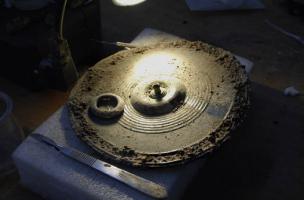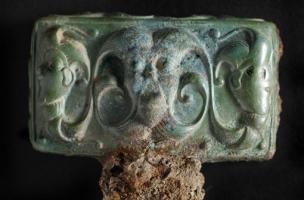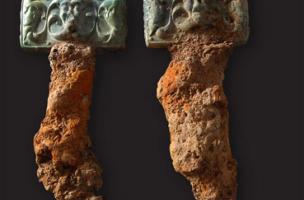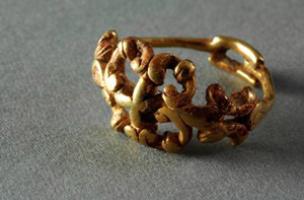You are here
Aristocratic Celtic grave goods discovered by Inrap now being restored by Conservare (Compiègne)
Of the 300 excavations conducted yearly by Inrap, approximately 30% concern the Iron Age, a period which is currently the subject of intense research activity. While we cannot reduce the study of Celtic society to its elites, mortuary rites and aristocratic burials still offer the most spectacular discoveries. Inrap recently excavated several individuals buried with their ceremonial or combat chariots.
The metal objects contained in these graves reveal the technical mastery and artistic inspiration of the Celtic artisans.
A large number of these objects are now undergoing restoration at the Conservare Institut (formerly IRRAP) in Compiègne.
Orval
All that is left of the two-wheeled chariot deposited in the grave is related to the wheels, the connections between the axle and the body, and, exceptionally; rein-rings.
The bronze head of two chariot pins is decorated in bas-relief with one face viewed straight on and profiles on either side. These pieces belong to the "plastic" style dated to the end of the Early La Tène period (around 350-350 BC).
All that remains of the deceased human are his weapon and a few personal objects, including an unusually long iron spear head (nearly 70 cm), a sword in its sheath and a very beautiful gold ring.
Livry-Louvercy
Dated to the 5th century BC, this grave was constructed for a two-wheeled chariot and contains a bronze bracelet and brooch, harness elements (2 bits, 2 bronze phalera with a coral cabochon), a ceramic drinking service (pots and goblets) and an offering of a gigot of mutton.
The grave pit was opened during the Celtic period, not to be pillaged, but to collect the highly refined wheel coverings, which were considered to be of great value at the time.
Vasseny
There were forty graves in the Vasseny cemetery (Aisne), which dates from 450-350 BC. Most of the dead belonged to the elite class. The objects that accompanied them into the after-life are specific to their sex and rank in Gallic society.
The men are equipped with their weapons: daggers, swords, shields, lances and javelins. These objects are sometimes accompanied by tools and toilet utensils (tweezers, razors, etc.). The women wore torcs, brooches, bracelets, bronze earrings, and beads of amber or two-toned glass. The bronze torcs (wide rigid necklaces) were often decorated with coils and, in one case, coral.
Two men and one woman were buried in three chariot graves, which shows that they had the highest hierarchical rank of their community. As at Livry, the wheel coverings were removed during the Gallic period.
One of the women wore a small bronze pendant decorated with the image of a person whose legs form a lyre. Human representations are rare during this period, and this evocation of a lyre is the earliest known from the Celtic world.
Raillencourt-Sainte-Olle
The Celtic Aristocracy of the La Tene period
Conservare
Conservare treats nearly 2,000 objects per year, half originating from museums in France and half from preventive archaeology. Some notable examples are projects realized for the department of the Arts of Islam of the Louvre Museum, the Musée de la Marine, and numerous local museums, including those of Amiens, Beauvais, Charleville-Mézières, Châteaudun, Compiègne, Moulin, Soissons, Reims, Senlis, Rouen and others.
In the context of preventive archaeology, Conservare has conserved objects from numerous sites along the TGV high speed train line to the East, and treated and conserved objects from Gallic graves.



Mahaut Tyrrell
Media communication
Inrap, media partnerships and relations department
+33 (0)1 40 08 80 24
mahaut.tyrrell [at] inrap.fr



